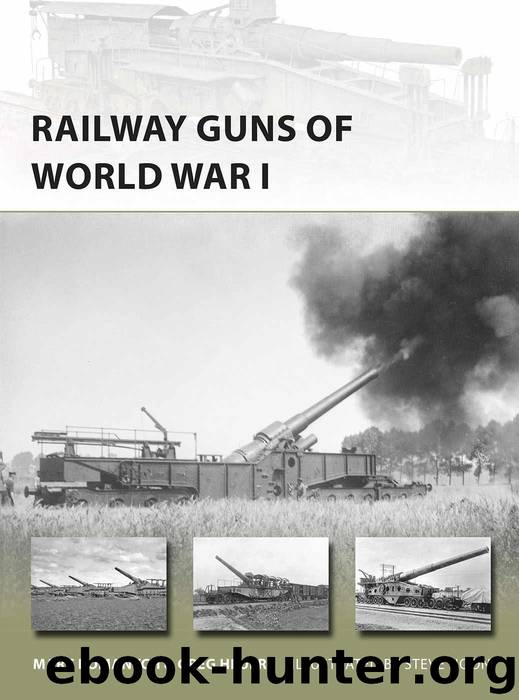Railway Guns of World War I (New Vanguard) by Marc Romanych & Greg Heuer

Author:Marc Romanych & Greg Heuer [Romanych, Marc]
Language: eng
Format: azw3
ISBN: 9781472816412
Publisher: Bloomsbury Publishing
Published: 2017-08-24T04:00:00+00:00
The British Army valued mobility and all-around traverse for its railway guns. This 9.2in Gun Mark XIII, operating without its outriggers, is emplaced in the sector of the New Zealand Division in May 1918.
(IWM Q 10530)
The French 240mm Mle 1893/96 ‘Colonies’ was a rebuild of Saint-Chamond’s 305mm Mle 1893/96 (châssis) using smaller-calibre cannons. Despite having a turntable mount and outriggers and braces to anchor the carriage, the gun did not have all-around traverse. (G. Heuer)
The German Army brought its four 24cm ‘Theodor Karl’ E. guns into action in the spring of 1917 against French forces in the Aisne and Champagne and British forces in Flanders. The guns were valued as mobile artillery, but their limited traverse and elevation were deemed unsatisfactory. Krupp then redesigned the ‘Theodor Karl’ gun as a dual-role E.u.B. gun that could fire directly from the railway tracks as before, but now could also demount from its bogies and be placed on a ground platform for all-around traverse and greater range. The redesign completely changed the carriage and added screw jacks for lifting the carriage off its bogies, a pivot mechanism for attaching the gun to its platform, and traverse rollers to rotate and support the rear half of the carriage. Several days were needed to install the ground platform, but once completed, the ‘Theodor Karl’ E.u.B. could be emplaced on the platform in about 15 minutes. The first platforms were made of concrete, but later, removable steel platforms that could be reused and emplaced elsewhere came into use. On the Belgian coast, a Vögele turntable, named after the company that built it, was fielded. The mount resembled turntables used in rail yards to turn locomotives around, and depending on the size of the railway gun affixed, up to 360-degree rotation was possible. The new ‘Theodor Karl’ E.u.B. guns first entered service in summer 1917, operating on both the Western and Eastern fronts. By early 1918, 22 ‘Theodor Karl’ E.u.B. guns were in service and, with a range of 26,600m when firing from a ground platform, they became the workhorses of German long-range artillery. A larger, sturdier carriage design, similar in function to that of the ‘Theodor Karl’, was used to build 20 28cm S.K. L/40 ‘Bruno’ E.u.B. pieces for naval artillery batteries in Flanders.
Download
This site does not store any files on its server. We only index and link to content provided by other sites. Please contact the content providers to delete copyright contents if any and email us, we'll remove relevant links or contents immediately.
| Automotive | Engineering |
| Transportation |
Small Unmanned Fixed-wing Aircraft Design by Andrew J. Keane Andras Sobester James P. Scanlan & András Sóbester & James P. Scanlan(32574)
Navigation and Map Reading by K Andrew(4889)
Endurance: Shackleton's Incredible Voyage by Alfred Lansing(4506)
And the Band Played On by Randy Shilts(2014)
Wild Ride by Adam Lashinsky(1870)
The Box by Marc Levinson(1863)
Top 10 Prague (EYEWITNESS TOP 10 TRAVEL GUIDES) by DK(1851)
The Race for Hitler's X-Planes: Britain's 1945 Mission to Capture Secret Luftwaffe Technology by John Christopher(1741)
The One Percenter Encyclopedia by Bill Hayes(1717)
Trans-Siberian Railway by Lonely Planet(1629)
Girls Auto Clinic Glove Box Guide by Patrice Banks(1620)
Looking for a Ship by John McPhee(1573)
Batavia's Graveyard by Mike Dash(1549)
TWA 800 by Jack Cashill(1523)
Fighting Hitler's Jets: The Extraordinary Story of the American Airmen Who Beat the Luftwaffe and Defeated Nazi Germany by Robert F. Dorr(1517)
Troubleshooting and Repair of Diesel Engines by Paul Dempsey(1498)
Good with Words by Patrick Barry(1496)
Bligh by Rob Mundle(1489)
Ticket to Ride by Tom Chesshyre(1479)
